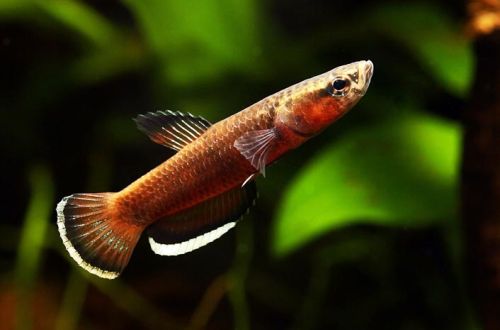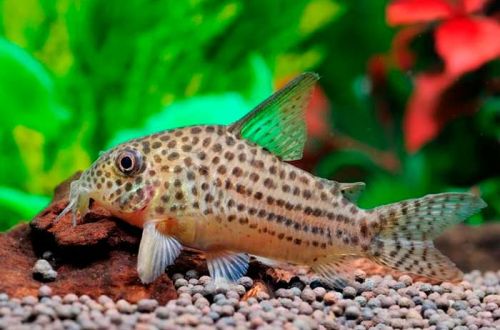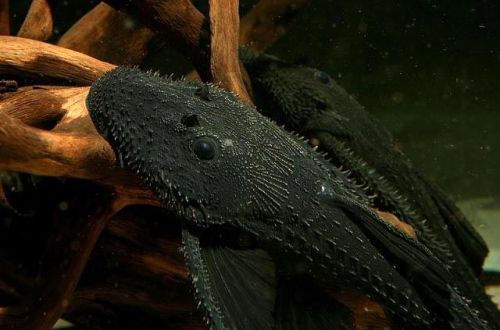
Betta albimarginata
Betta albimarginata or White-rimmed Cockerel, scientific name Betta albimarginata, belongs to the Osphronemidae family. Bright beautiful miniature fish. However, all these epithets refer to males. Females are not so expressive in coloring. Quite difficult to maintain and requiring careful selection of neighbors. Not recommended for beginner aquarists.

Contents
Habitat
It comes from Southeast Asia from the Indonesian part of the island of Borneo. It is considered endemic to the Sebuku River Basin in the province of Kalimantan Timur (East Kalimantan). It inhabits shallow forest streams, the depth of which is only 5–10 cm, littered with a layer of leaves, branches and other plant debris.
Brief information:
- The volume of the aquarium – from 40 liters.
- Temperature – 23-28°C
- Value pH — 4.0–6.5
- Water hardness – 1–5 dGH
- Substrate type – any dark
- Lighting – subdued
- Brackish water – no
- Water movement – little or no
- The size of the fish is about 3 cm.
- Food – any food
- Temperament – peaceful
- Content – in a pair or group together with other species
Description
Adult individuals reach a length of about 3 cm. This species has a pronounced sexual dimorphism. Males are painted red, and their large fins and tail have a contrasting black and white edging. Females look not only variegated with a predominance of gray shades with black irregular specks.
Food
Probably, in nature, insects and other small invertebrates and zooplankton are the basis of the diet. In the home aquarium, they are accustomed to alternative foods. The daily diet can consist of popular dry, frozen and live foods. A good choice would be specialized products for Betta fish, produced by some manufacturers.
Maintenance and care, arrangement of the aquarium
The optimal size of the aquarium for a small group of such tiny fish starts from 40 liters. They will look most harmoniously among thickets of shade-loving plants and numerous snags against the background of a dark substrate. The lighting is subdued. Bright light adversely affects the brightness of the color. A useful addition will be the dried leaves of some trees, which are an integral part of the natural habitat of White-rimmed Cockerels. They serve not only as a natural design element, but also play an important role in establishing the composition of the water similar to that in which fish live in nature. In particular, when decomposed, the leaves release tannins that color the water brown. Read more in the article “Which tree leaves can be used in an aquarium.”
Successful keeping is possible only in conditions of very low pH and dGH values, which can be difficult to maintain for a beginner aquarist. Particular attention should be paid to the filtration system, which, in addition to cleaning, can become a tool for influencing the hydrochemical composition. In addition to the positive effect, some filter models create excess water movement, which should be avoided in the case of Betta albimarginata, which is not adapted to strong currents.
Behavior and Compatibility
Due to their modest size, they can only be compatible with small fish of comparable size. Large and overly active species can intimidate these little Bettas. Intraspecific relationships are built on the rivalry of males for the attention of females. Competition is accompanied by interesting behavior and encourages males to display their best colors. It is recommended to support in pairs and groups.
Breeding / breeding
In the natural environment, where cases of drying up of shallow water bodies are not uncommon, the fish have developed appropriate adaptations that allow them to keep the brood even in such a changeable environment. Cockerels hatch eggs in their mouths, and only males do this. With the onset of the breeding season, the fish form a temporary pair. During spawning, the female releases only a dozen eggs, after fertilization of which they immediately end up in the male’s mouth. The small clutch size is compensated by the high survival rate of juveniles in comparison with other species. The incubation period lasts 10–21 days, during which the male seeks to retire to a safe place or shelter. He should be protected from stressful situations (you can’t scare him) and the attention of too curious neighbors in the aquarium, otherwise he can swallow the eggs. The fry appear fully formed and can be near their parents, who, however, later lose interest in them, but will not try to eat them.
Fish diseases
The cause of most diseases is unsuitable conditions of detention. A stable habitat will be the key to successful keeping. In the event of symptoms of the disease, first of all, the quality of the water should be checked and, if deviations are found, measures should be taken to correct the situation. If symptoms persist or even worsen, medical treatment will be required. Read more about symptoms and treatments in the Aquarium Fish Diseases section.





